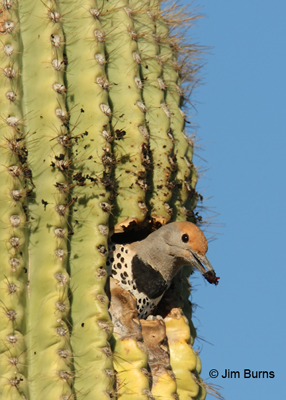
Not to worry, though, this doctor still makes house calls. The next day, after an on site inspection, he allayed my fears that the large saguaro in our front yard might be dying. It had sustained frost damage, perhaps as long ago as two winters, but he found no evidence of bacterial infection either around the blackened woodpecker hole near the top nor at the saguaro's base.
Bacteria necrosis is a disease which only attacks saguaros. Usually fatal if not treated, it can be caused by overwatering, heat stress, frost damage, or invasion by a metal object. Treatment typically involves surgery, and the Cactus Doctor is an experienced and successful saguaro surgeon.
Here's what this has to do with birds. The saguaro cactus, the state flower of Arizona, is known as the "desert apartment complex" because nearly two dozen species of birds have been known to nest in saguaros, most of them utilizing holes originally drilled by our two desert woodpeckers, the Gila woodpecker and the gilded flicker. If you're a saguaro aficionado you know most larger saguaros have multiple holes and, if you're a birder, you've noticed that these older saguaros often house multiple species at the same time in the same season.
Here's a partial directory of the residents who benefit from the woodpeckers' saguaro handiwork--peach-faced lovebirds, elf owls, ash-throated flycatchers, purple martins, Lucy's warblers, and of course the woodpeckers themselves. And right on the top floor of this apartment complex all these and many other nonresidents such as doves, hummingbirds, thrashers, and verdins visit the "desert supermarket" to feast on the pollen, nectar, insects, and petals of the saguaros' white blooms and subsequent ripe red fruit.
Infection works on saguaros just as it does on birds and humans. If any of this myriad number of saguaro nesters and shoppers happens to visit a cactus that is infected, its bacteria may be carried to the bird's next stop. The saguaros, however, secrete a fluid at the site of avian wounds which hardens to protect them from bacterial invasion. These hardened pockets are the "saguaro boots" often found near fallen cactus.
As you would suspect of an infectious disease specialist, the Cactus Doctor keeps busy. You can reach him at thecactusdoctor.com. And if your cactus is stressed but not diseased, he will spray wounds and holes with a disinfectant as he did ours.